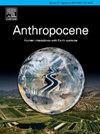受dwh影响的底部沉积物向下坡沉积物中心重新分布的可能性:墨西哥湾东部
IF 3.9
2区 地球科学
Q2 ENVIRONMENTAL SCIENCES
引用次数: 0
摘要
2010年深水地平线(DwH)漏油事件导致大约490万桶石油泄漏到墨西哥湾东北部。在沉积物脉动的过程中,许多被迅速输送到海底,但受石油污染的沉积物的最终命运仍然未知。本研究探讨了初始DwH冲击区内的底部沉积物在下坡沉积物中心被动员和再沉积的可能性。在初始海底撞击区250 km下坡范围内的31个地点采集了沉积物岩心,以寻找沉积物再分布的证据,以及沉积物源区是否包括初始撞击区。31个地点中有27个含有沉积物再分布的沉积构造,主要是由低密度浊度流引起的。沉积物再分布的其他证据包括底栖有孔虫断裂百分比升高,快速和脉冲积累速率以及广泛的远洋沉积的缺乏。沉积物以硅屑泥为主,次为碳酸盐砂质泥。最有可能的硅塑性泥浆来源是密西西比河三角洲和邻近的大陆边缘,因为它直接从研究区域向上倾斜。该区域包括DwH海底影响区。在冲击带东南96 km范围内的13个岩心地点,在不同时间(2010年后)沉积的沉积物中检测到DwH油残留物,这与能够长距离输送含油沉积物的多次再分布事件相一致。这项研究的结果不仅对制定未来污染物泄漏的缓解战略很重要,而且由于沉积物再分配过程可能具有相当大的破坏性,有关过程类型和频率的信息对于规划未来的海底活动至关重要。本文章由计算机程序翻译,如有差异,请以英文原文为准。
Potential for redistribution of DwH-impacted bottom sediments to down-slope depocenters: Eastern Gulf of Mexico
The 2010 Deepwater Horizon (DwH) oil spill was responsible for dispersing an estimated 4.9 million barrels of oil into the northeastern Gulf of Mexico. Much was transported rapidly to the seafloor during a sediment pulse, but the ultimate fate of the oiled sediments remains unknown. This study investigates the potential for bottom sediments within the initial DwH impact zone to be mobilized and redeposited in down-slope depocenters. Sediment cores were collected from 31 sites up to 250 km down-slope (SE) of the initial seafloor impact zone to search for evidence of sediment redistribution, and whether the sediment source area(s) included the initial impact zone. Twenty-seven of the 31sites contained sedimentary structures indicative of sediment redistribution, primarily by low density turbidity currents. Other evidence of sediment redistribution includes elevated benthic foraminiferal fracture percentage, rapid and pulsed accumulation rates and the paucity of extensive pelagic deposition. Sediments consist dominantly of siliciclastic muds, with subordinate carbonate sandy muds. The most likely source for siliciclastic muds is the Mississippi River Delta and adjacent continental margin as it is immediately up-slope from the study area. This area includes the DwH seafloor impact zone. DwH oil residues were detected in sediments deposited at different times (post 2010), at 13 core sites, up to 96 km SE of the impact zone, which is consistent with multiple redistribution episodes capable of transporting oiled sediments long distances. Results of this study are not only important for developing mitigation strategies for future contaminant spills, but as sediment redistribution processes can be quite destructive, information regarding process type and frequency can be vital for planning future activities on the sea floor.
求助全文
通过发布文献求助,成功后即可免费获取论文全文。
去求助
来源期刊

Anthropocene
Earth and Planetary Sciences-Earth and Planetary Sciences (miscellaneous)
CiteScore
6.30
自引率
0.00%
发文量
27
审稿时长
102 days
期刊介绍:
Anthropocene is an interdisciplinary journal that publishes peer-reviewed works addressing the nature, scale, and extent of interactions that people have with Earth processes and systems. The scope of the journal includes the significance of human activities in altering Earth’s landscapes, oceans, the atmosphere, cryosphere, and ecosystems over a range of time and space scales - from global phenomena over geologic eras to single isolated events - including the linkages, couplings, and feedbacks among physical, chemical, and biological components of Earth systems. The journal also addresses how such alterations can have profound effects on, and implications for, human society. As the scale and pace of human interactions with Earth systems have intensified in recent decades, understanding human-induced alterations in the past and present is critical to our ability to anticipate, mitigate, and adapt to changes in the future. The journal aims to provide a venue to focus research findings, discussions, and debates toward advancing predictive understanding of human interactions with Earth systems - one of the grand challenges of our time.
 求助内容:
求助内容: 应助结果提醒方式:
应助结果提醒方式:


